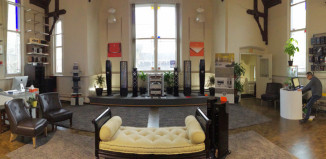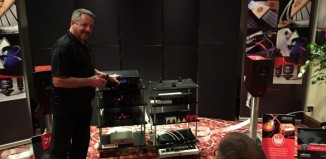
Television goes digital
For a technology that has been around and virtually unchanged for 50 years, television is making huge leaps in quality and features.
According to published sources, colour was added to television in 1953. While black and white had been around since the 1940s, colour didn’t become popular until the television manufacturers developed programs to help market colour sets in the 1960s. If you’ve ever wondered why so many pastels were used in shows like the original Star Trek, and why Adam West wore a lavender Batman costume, conventional wisdom says it’s because it was a great way to help sell colour televisions.
Now, thanks to the digital technology that has advanced audio and computing, television is making its first real technological leap in 50 years.
Digital television is divided into two main categories: High Definition Television (HDTV) and Standard Definition Television (SDTV).
HDTV (High Definition Tele Vision) combines a wide-screen picture similar to those shown in movie theatres, with multi-channel audio, in an attempt to recreate the theatre experience.
In addition to the obvious technological dissimilarity, conventional analog TV differs from digital HDTV in three ways: picture quality, aspect ratio, and audio.
HDTV delivers sharper picture quality that is vastly superior to that of regular TV. Colours are exceptionally vivid, including subtle purples and reds, provided with less bleeding. In television video, bleed means blurring, and refers to the fuzziness of colours, especially at the edge of a picture.
For each pixel in conventional TV, HDTV has 4.5 pixels. Depending on the resolution, the greater number of pixels means a greater number of coloured “dots” making up the picture, therefore making a better quality picture.Television sets designed for HDTV signals have noticeably wider screens than those of traditional televisions. Existing television screens are nearly square, while digital sets are rectangular. This size difference allows digital sets to take full advantage of the higher-resolution picture and provide six times the picture content over existing conventional TV systems.
The measurement of screen width and height, referred to as aspect, is expressed as a ratio. HDTV screens have an aspect (width to height) ratio of 16:9.
That’s a huge difference when compared to the 4:3 aspect ratio of basic analog television. HDTV is about 1/3 wider than conventional TV.
When transferred to the 4:3 analog television aspect ratio, movie images must be stretched. This stretching to fit the television screen contributes to what in almost any other area would be referred to as “distortion”.
In an older movie formatted to conventional TV, a young Marlon Brando might look like an anorexic basketball player. In a movie made in the last 20 years, Brando’s Jabba the Hutt physique might be stretched to merely “chunky” proportions.
On an HDTV, Brando will look more like Brando, whatever the era.
HDTV provides highly advanced Multi-Channel Digital Sound Quality with Dolby Digital Audio, also known as AC3, with 5.1 discrete, or separate, audio channels. Dolby Digital 5.1 Surround Sound completes the HDTV package.
In the old days of stereo, or maybe even right now as you contemplate purchasing new television and stereo equipment, you may have connected your television and VCR to a stereo receiver. If you had two speakers, this would provide you with left and right channels, plus the full-range sound of the television speaker. By adding another pair of speakers to your room, you could have left front, left rear, right front, and right rear, plus the full range television, or “centre” speaker. This could be a low-tech version of “surround sound”.
The Dolby digital audio 5.1 standard takes the efforts of home audio enthusiasts to another level, by delivering separate sound to each speaker, or “channel”. The “point one” refers to the sub-woofer that provides the very low frequencies. Because low frequencies are difficult to aim, and they are separated via electronic crossover instead of separated, the subwoofer isn’t really a channel. Hence it’s called “point one” (.1) instead of “six”. Five point one also sounds cooler and more technical.
You can benefit from HDTV multi-channel audio by connecting your true home theatre sound system.
To watch HDTV you need a television set that is capable of receiving the HD signals. The signals can be sent from your local cable company, your satellite provider, or your local broadcaster. To receive signals from a local over-air broadcaster, your HD television set must have a built-in tuner and antenna, or for better reception, a place to connect an exterior antenna.
Not all areas have HDTV. If it is available in your area, to view the HDTV broadcast you’ll need a minimum of an HDTV-compatible television set; a satellite dish or digital cable subscription and connection; and a special HDTV set-top-box provided by your local carrier.
Unlike conventional television, HDTV offers new future possibilities, because it uses a high bit rate channel. This high bit rate channel provides broadcasters with the means of transmitting new value-added services, such as interactive TV, to viewers in the future.
HDTV has been accepted and in use in Japan since 1991, and Europe for years. South of the border, in the US, HDTV has already been accepted. American broadcasters have had to meet HDTV broadcast deadlines before Canadian broadcasters.
Stations in the largest US markets had to make the transition to digital by May 1,1999. Most equipment had to be replaced or converted. Stations also had to retrain staff, design sets that fill the panoramic HDTV screen, and sometimes find sites for new transmitters. Changing over a single station can cost millions of dollars.
The US government expects that by 2008, most people in the United States will own digital sets or at least have conversion boxes for their old sets. At that point, everyone will need a digital receiver to continue watching television.
Canada may have been a leader in HDTV content. One source claims that in 1987 a CBC mini-series called Chasing Rainbows was one of the first, if not the first, TV program of its kind to be shot entirely on Sony HDTV equipment.
But when it comes to adoption and legislated deadlines, in typically Canadian fashion, Canada lags behind almost every other developed country.
The CRTC (Canadian Radio Telecommunications Commission) has decided that “Digital technology will be treated as a replacement for analog technology”, and as such, “a voluntary, market-driven transition model, without mandated deadlines, would be the most realistic and appropriate approach for Canada to adopt.” Meaning there is neither a legislated nor bureaucratically decided deadline for the adoption of HDTV in Canada.
It seems the CRTC has responded to “concern…expressed about the difficult business decisions that confront small market broadcasters in their efforts to weigh accurately the benefits and costs of converting to DTV.”
As the Canadian market is smaller, and spread out over the second-largest country in the world, it might take a little longer to get HDTV signals out to every viewer.
Thankfully for those with HDTV sets, it’s already happening. In August 2003 specialty channels Discovery and TSN began broadcasting HDTV signals, becoming the first specialty channels to do so.
Broadcasters capable of delivering HDTV signals include Bell Express Vu, Shaw Cablesystems, Starchoice, Rogers Cable, Videotron, and Mountain Cablevision. Rogers subscribers can choose up to 17 different HDTV channels, in addition to a 24-7 HDTV demonstration channel.
CityTV is broadcasting in High Definition now. CTV launched HDTV service in November 2003 over satellite and some cable services. Other broadcasters have their digital licenses applications in place with the CRTC.
According to Electro Federation Canada, approximately 800,000 households have purchased HD-capable television sets. Electro Federation estimates that by 2006, HDTV penetration could reach 23.4% (2.85 million) of Canadian households.
If you haven’t made the switch to HDTV yet, and instead of embracing the new standards, you are adapting to the new technology at your own adoption rate, have no fear. Choosing not to upgrade won’t prevent you from watching the new signals.
For the time being, you’ll still be able to continue watching analog broadcasts, cable, videocassettes, DVD, and satellite. You’ll also be able to enjoy HDTV broadcasts using a DTV-to-NTSC set-top box. The set-top box will deliver many of the benefits of DTV broadcasting, including HDTV programming, superior picture, and clear sound. However, an analog television cannot display the full quality of High-Definition images or sound.
HDTV broadcasts are meant to be “backwards compatible”. Your old analog TV and stereo will still work, but you won’t enjoy the full benefits.
When shopping for a new television, you’ll soon encounter some potentially confusing new terms, like resolution, pixels, HDTV-ready, and HDTV-compatible.
Tiny horizontal lines make up TV images. More scan lines mean better resolution.
Analog televisions deliver pictures composed of 480 interlaced lines of resolution, scanning at 30 frames per second. This system is abbreviated as 480i or 480/30i.
Digital televisions display formats from 480i and 480p (480 progressively drawn lines of resolution, like a computer monitor) to 720p resolutions. Current DVDs are produced to display digital progressive 720×480 resolution.
The HDTV picture has 1080 or 720 lines of resolution, depending on the format.
HDTV-ready means the set is ready to receive HDTV signals.
HDTV-compatible refers to lower (852 x 480) resolution screens with HDTV converters. These sets provide a better HDTV picture than a conventional television with enough resolution to be considered fully HD.
The minimum performance attributes for HDTV are:
Picture Quality: A vertical display resolution of 720 pixels, resulting in 921,600 pixels per frame, or 1080i or higher, delivering a picture of over 2,000,000 pixels.
Aspect Ratio: Capable of displaying a 16:9 image at the minimum resolution level. Should your HD set be a 4:3 natural display, the HD signal will be letter-boxed to a 16:9 aspect ratio, and the set manufacturer will identify the number of active scan lines: 540 in progressive, or 810 for interlaced formats.
Tuner: receives all ATSC Table 3 formats and displays them in their original format.
Audio: Receives, reproduces, and/or outputs Dolby 5.1 digital audio.





